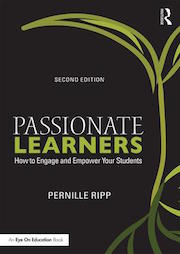How to Get Your Students Blogging!
Three years ago I started blogging with my 4th grade students on a whim. I knew three things at the start: I wanted to get them connected with each other; I wanted to give them a voice, and I knew I had to change the way they wrote.
So I started blogging with them – fumbling my way through the how to and the when to.
What I had no way of knowing was how blogging would change the way I taught, how blogging would give my students a way to speak to the world, and how blogs would make it possible for them to create lasting global connections with other children.

We no longer just wonder how things are done in other countries. We blog and ask questions and get our answers.
So when I meet with any teacher who wonders how to lower the walls of their classroom and create more authentic learning opportunities, my first advice is to get students blogging.
If they’re interested, I share these steps. They grow out of my own experience working with upper elementary-aged kids, and I believe they can help any middle grades teacher successfully launch a blogging program and integrate it into the daily learning experience.
10 + 1 Steps to Meaningful Student Blogging
Here’s the checklist I follow myself at the beginning of each year, before I unleash my (now) 5th grade students’ voices to the world:
1. Figure out your why
You have to reflect on why it is you want to have students blog. Is it to make connections, for technology integration, to give your students a voice, or for some other reason? If you know the why it is much easier to get students excited about the blogging experience. I don’t feel that blogging should be just to show off student work; it can be something much bigger than that. So figure out your reasons why before you move on to the how.
2. Pick your platform
I use Kidblog because of its ease, its wonderful safety features, and the ease with which I can adapt it to fit our purpose. While some feel (as a result of recent changes) that Kidblog is geared more toward early elementary students, I disagree. But it’s not the only safe and easy-to-use option: Edublogs is another popular student blogging platform that also comes highly recommended.
3. Get your permissions

I’ve created my own permission slip to ensure that parents feel well informed as they make their decision about whether to let their child blog. And I have yet to have a parent say no.
4. Blogging versus writing
I always introduce blogging by discussing how it is similar and different to writing. Students often get what blogs are but not necessarily how they can use one themselves. So I showcase my own professional blog and other students’ blogs to get them excited about the adventure they are about go on. We discuss what we can blog about, how long a post should be (as a minimum), and what to do about spelling and grammar. These discussions lead to heightened awareness of what is appropriate for a blog post and what isn’t and will also lead to the next step.
5. Discuss safety!
Before students ever log into their blog accounts for the first time, you have to discuss safety. I use the analogy of “Why the Internet is Like the Mall” to get students to really think about their online behavior and what they post. This is an in-depth discussion that covers many aspects of internet behavior, not just those that are specific to blogging. This is also not just a beginning-of-the-year conversation, but an all-the-time conversation.
6. Do a paper blog

7. Discuss commenting
For blogging to be effective, students need to know how to make good comments. Commenting on other blogs is one important way to grow an audience for your own blog. And when people comment on what you have written, you need to be prepared to respond with follow-up comments of your own. So we discuss how to create a dialogue in comments, how to thank people, and also how to give constructive feedback. We set up parameters for our posts and our comments in order to uphold a high standard of writing and we discover how commenting can (and should) become a conversation. We even act out comments from our post-its to see if they work well as conversation starters or act as dead ends. Students quickly realize the power of a comment.
8. Start small
When students are finally ready to blog, have them introduce themselves. That way, as your class starts to reach out to others (because ultimately blogging is about connections), students can showcase themselves and thus spark a conversation.
9. Connect with others.

This is what gets the kids excited about blogging — it’s not just that they get to read other posts, they are able to establish a personal connection with other kids in faraway places, maintain that relationship throughout the year, and learn a lot about life in other parts of the globe.
10. Make it their own
Students need to feel genuine ownership of their blogs. I ask them for ideas of what to blog about; I give them free artistic rein over their posts, and I give them time to explore the blog’s tools and capabilities. This is what gives students ownership and has them take pride in their blogging. If it is truly their voice being heard in whatever fashion they want to present it, then they are eager to show it off.
Blogging has to be authentic for it to work. I don’t correct their grammar and spelling. I don’t require editorial changes unless something is likely to lead to hurt feelings or misunderstandings. I will ask them to add more or to explain further, but I give them the time to do so. I also challenge them with a weekly blogging challenge and then find time to do it in school. (Ideas for the challenge come from students or things I wonder about myself.)
11. Give it time
Great blogging and great connections don’t happen overnight, so give it time. Let the students develop as bloggers, celebrate their successes, and map their connections. Truly celebrate the blogging they do and spend time on it class. Encourage blogging but don’t make it an assignment to just get done. Treat it as an integral part of your classroom and watch it become one. Blogging is not just about writing, it is about bringing the world in and making it a little bit smaller.
In the end, blogging should not be a burden in your already full day. Students should love blogging, not see it as a chore (which is also why I never grade my students’ blogs) and they should be eager to express themselves and expand their worlds.
If you are ever in need of someone to connect to or ask questions, please reach out to me @pernilleripp on Twitter. I will gladly help. After all, blogging is about expanding our own comfort zones and creating authentic, global collaboration.
(Bio updated September 2015)






































Thank you for such a concise, articulate, and organized post. We are getting more and more teachers to open their classrooms with blogging and your post says it all so well.
You are so very welcome, I am thrilled when anyone new wants to start blogging with students, it is life changing.
Figuring out your ‘why’ is so important . Not knowing that in advance was a stumbling block for me at first. I ended up writing about the many reasons you can start a blog: http://theedublogger.com/2013/01/24/why-are-you-blogging-guest-post/
In the end, I found that some students were drawn to blogging, others were not. But, blogging really increased student motivation for revising and editing :).
I love this article and the permission slip is terrific. I used kidblog this past school year for my students to blog and comment about novels in their literature circles. I was astounded at the depth of the work some of them did and how easily they adapted to the blogging format (thanks probably to their use of Facebook or other platforms). Other students found themselves reaching out to explain their thoughts on the books we read and it seemed they loved the whole process. I’d definitely do it again, but I’ve learned to put some safeguards in since some did ‘push the envelope’ which I hadn’t expected, unfortunately!
Thanks for this post! I was looking for something just like this as I am trying to encourage teachers to use blogging to complement their writing programs in class. We are a K-6 school and there are so many benefits. Thanks for posting!
That is really good — well done
This is fantastic! Thanks for sharing such great tips and resources:)